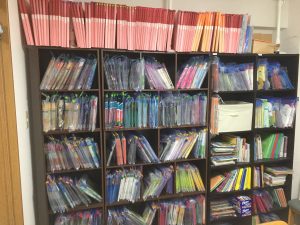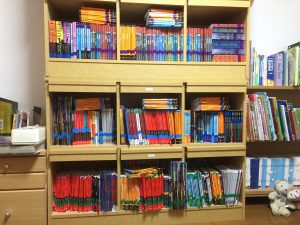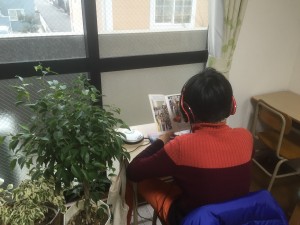Academy business curriculum extensive reading high school JHS junior high school language courses Language learning school management SHS
by sendaiben
6 comments
Cambridge Academy: December 2016 Update

Academy beginner book section (YL0.1-0.7)
You can read about the Cambridge Academy in previous posts:
- Extensive Reading for Secondary Students (April 2015)
- Six Months In (September 2015)
- Year One (February 2016)
- Looking at Year Two (March 2016)
- Stocktake (March 2016)
- Shadoku explained (April 2016)
- Some improvements to the curriculum (April 2016)
Well, a lot has happened since my last post about the Academy (July 2016). We have had several schools visit, and I have talked to lots of people, and I have realised that in order for someone to start a program like the Academy in a school, the following four conditions are necessary:
- the desire and autonomy to begin a program
- the knowledge of ER to explain it to teachers, parents, and students
- a critical number of junior and senior high school students
- a large amount of money for books
So far I haven’t talked to anyone with all four of these, so we are putting our plans to license our system on hold. After all, if there are no potential customers it doesn’t make much sense to develop a product, right?
I’m still very happy to answer questions and give what advice I can though -feel free to leave a comment on this post or drop me an email.
Progress Report
We’re approaching Year Three for the Academy, and a lot is going well, and some things are going less well. We haven’t seen the growth I was hoping for (100 students are still out of reach), but we have a solid 70-some and next year is looking somewhat hopeful to break three figures.
1. Shadoku/Students that didn’t do shadoku last year
Our new first year reading curriculum incorporating shadoku is working extremely well. This year’s first year students are possibly doing better than last years’ (who are now second years). The second years are struggling a bit and I am trying different things to help them out, including having them re-read at a much lower level, etc. Not sure if the situation can be fixed completely, but at least we’ll do better going forwards.
We’ve also bought a lot of new books, particularly at the intermediate and advanced levels. Still not enough, but much closer to being able to meet our students’ future needs.

Academy intermediate book section (YL0.8-2.9)
A few of our students are really taking off with their reading, breaking the YL2.0 barrier and becoming more independent and motivated readers. It’s wonderful to see.

Academy advanced book section (YL3.0~)
I would say that somewhere over half our students are doing really well, and most of the others are doing okay. Maybe 20% are not doing well, and I hope some of them can be salvaged. Most of the ones who are not doing well started off badly, and I wasn’t skilled enough at the time to notice or help them.
2. Student reading targets
I’ve also noticed that students that read a certain amount are doing well, and those that read less are not. Using this data, I have come up with provisional weekly targets that we’ll start using next year with our students:
JHS1 2000-5000 words a week (100,000-250,000 words a year)
JHS2 3000-7000 words a week (150,000-350,000 words a year)
JHS3 4000-10000 words a week (200,000-500,000 words a year)
SHS1 4000-10000 words a week (200,000-500,000 words a year)
SHS2 5000-15000 words a week (250,000-750,000 words a year)
SHS3 6000-20000 words a week (300,000-1,000,000 words a year)
Based on these a student that joined our program in JHS1 and stayed with us until the end of high school would read 1,200,000 to 3,350,000 words. I predict this would provide them with some pretty decent English skills. The targets include in-class reading as well, so students with decent reading speeds might be able to clear the target just by reading in class for 55 minutes a week.
These numbers are provisional and we’ll probably adjust them after working with the students a bit next year. Looking at our current student data though, they seem reasonable. For comparison, in my university classes I require students to read 8,000 words a week to pass the course and 25,000 words a week to get a top grade.
3. Original junior high school output (speaking and writing) curriculum
We’re currently working on making our own curriculum for junior high school students for the output (speaking and writing) classes. As I mentioned in the improvements to curriculum post, the output classes have actually proven to be extremely important, and in the future we’ll be recommending students take both classes if at all possible.
Reading classes are much more profitable, but so far the results of students that only take reading are not satisfactory so we’ll have to abandon that idea as a profit centre 🙂
We should have the original curriculum for JHS1 ready to try from April, and then develop year two in 2017 and year three in 2018. Using the new curricula, we will now place junior high school students in their equivalent year class instead of trying to stream them by ability. High school students will be streamed by ability/level.
4. Assistant teachers
We have a couple of assistant teachers this year. They were students in the program last year, and are now attending local universities. We asked them to help us out as part-time staff.
The huge advantage of recruiting assistants like this is that they are very familiar with the system. It’s a win-win: we get dependable and skilled assistants that we know and trust, and they get to continue their English studies while doing fairly well-paid and interesting part-time work.
Best of all, this model should be fairly sustainable: I would expect we’ll have at least one suitable student per year graduating and we can keep them for four years while they are at university.
5. The next steps
Right now we need to do a few things before the end of the year. I would like to write a student guide to the curriculum that explains what they need to do. I think this will help students and their parents get more out of their classes.
We also need to buy some more books, although we can probably slow down a bit now.
Another stocktake will have to happen at the end of the year and book purchases to fill in holes.
We’re going to need more shelves soon too.
We’ll also be taking over another school and inviting their students to join our program from April. Hopefully this will build up our numbers a little bit.
All good stuff. I’m really looking forward to how the Academy develops as we go into our third year.
Anyone else working on extensive reading systems? Any questions or comments?
PRESENTATION: Children’s English Education @ Happonmatsu Shimin Centre
I did a presentation today for parents (mothers) of young children today on the topic of English education for children. The presentation was in Japanese, and I had a lovely group of people who seemed interested and asked good questions.
Here are my slides, cryptic as ever: 160706 Children Learning English
The questions at the end were submitted by participants prior to the event, which was a really nice touch as it gave me a chance to get my answers ready 🙂
Let me know if anything is unclear in the comments below!
curriculum extensive listening extensive reading Language learning speaking
by sendaiben
12 comments
Shadoku Explained
Adding shadowing to beginner extensive reading has immense potential
I’ve been meaning to write this post for a while. I’d like to thank Yuko Suzuki, who first told me about the huge potential of incorporating shadowing practice into extensive reading classes for beginners/lower-level students. If you have a chance to see one of her presentations I recommend you take it -she’s a very effective teacher and presenter.
So what is shadoku? Well, it is a term coined by me as a gag over lunch at a seminar in Fukuoka. I’m kind of chuffed that it has been adopted somewhat by the community 😉
Shadoku is shadowing and tadoku (extensive reading).
Shadowing is a type of speaking fluency practice that involves attempting to speak along with another person or an audio source. It is different from repeating. When doing read and repeat, for example, the source would speak first, then the learner would repeat. In shadowing, the source would speak, then the learner would attempt to say the same thing at the same time with the smallest lag possible. One feature of shadowing is that learners are encouraged to imitate the speaker’s tone, intonation, emotion, and pronunciation.
This video gives a brief explanation of shadowing.
So how does this work with tadoku (extensive reading)?
Well, I have only been experimenting with this for a few months, and we rolled it out to all the beginner students in the Cambridge Academy last week.
I have adapted (messed up?) Yuko’s technique slightly, so I will introduce my version of shadoku below.
For beginners (mainly junior high school first years and elementary students) I am planning to do shadoku as described below until they reach YL 0.4, at which point I may allow them to read and listen instead, or we may continue with shadoku if that seems appropriate at the time. Basically this year is another learning experience for me.
How to do shadoku
There are four steps in my version of shadoku, so a student will read each book four times.
Step one: look at the pictures, think about the content. At YL0.1-0.3 there are plenty of pictures in the books and students can guess a lot of the content just from that. This step takes a minute or two, and we encourage students to look closely at details in the pictures.
Step two: listen to the audio and read along silently. This step allows students to focus on how to pronounce words and how the English sounds when spoken.
Step three: listen to the audio, read along, and shadow out loud. This step allows students to shadow assisted by the text.
Step four: listen to the audio and shadow out loud. Do not open the book. This step allows students to use their listening skills and short-term memory to shadow successfully. I also encourage students to think about the meaning of what they are saying during this step.
Introducing shadoku
For the first three or four classes I have students do shadoku as a group, with me leading them. I introduce each step (I have a notebook with the four steps that I show to remind students), play the CD when necessary, and give students feedback and advice. Students shadow together as a group, which makes them feel less self-conscious and allows more confident/keener students to set a good example.

I use these diagrams to explain shadoku
After a few classes and once students are more confident, we do group shadoku at the beginning of class and then students work individually with headphones and personal CD players in the latter half. They are also expected to continue practicing in the same way at home.
The benefits of shadoku
I haven’t been using shadoku with my students for long, but already I am really happy with how things are going. I’ve been asking all our new students (starting at YL 0.1) to do shadoku, and am currently planning to have them continue until they reach YL 0.4 or so.
The main benefit is that students are much more involved in the task.
Previously when we did reading while listening some students were clearly zoning out. I had a couple who appeared not to have made any progress mid-year so I had to have them go back to the beginning and do intensive work reading to me, etc.
I can’t see that happening this year, as I can hear the students practicing and can monitor if they are getting the right pronunciation, intonation, etc.
The students also seem happier and the atmosphere in class is much better than last year.
Conclusion
This is still a work in progress. So far so good, but we’ll see if students get bored or some unexpected problem pops up. We’ll also have to see where it would be appropriate to stop doing shadoku in class and transition to reading and listening. I suspect it’s going to be when students move from YL 0.3 to 04, but I’m not sure and look forward to trying it out in a couple of months’ time.
Anyone else using shadoku? Anything to add?
curriculum extensive reading graded readers Language learning Oxford Reading Tree presentations Reading
by sendaiben
4 comments
VIDEO Oxford Teaching Workshop Series, Sendai 2015
I really enjoyed presenting at the Sendai Oxford Teaching Workshop Series last Sunday. It was great to present on home ground, and we had a fantastic audience on the day.
My presentation was “Reading: the key 21st Century skill” and made the following points:
- reading is very important, and should be part of all language courses
- non-fiction is often neglected, but many learners prefer it and it is sometimes easier to understand
- OUP has a nice range of non-fiction readers
- how to include reading practice in your classes
- how to design an extensive reading program
You can see the full presentation below:
Please let me know if you have any questions or comments 🙂
VUS TESOL 2014
I am extremely excited to have the chance to speak at VUS TESOL 2014 in Ho Chi Minh City this year. Slides, notes, and hopefully video to follow next week.
The website for the event is here.



